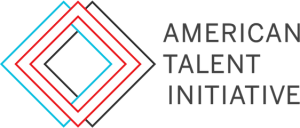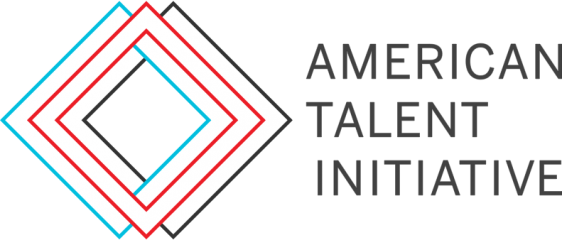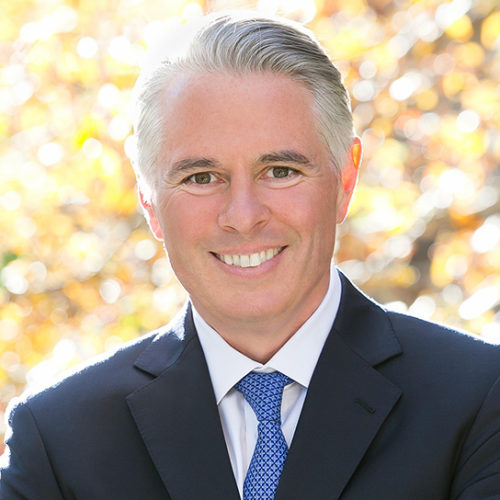
Quarterly Newsletter
Welcome to The American Talent Initiative quarterly newsletter – your source for news and insights on how we’re working toward our 50,000-by-2025 goal.
Presidential Perspectives: Eric F. Spina, University of Dayton

The University of Dayton aims to increase Pell-eligible student enrollment in each entering cohort from 14% in Fall 2017 to 20% by Fall 2023. We sat down with President Eric Spina as he reflected on his involvement with the American Talent Initiative, how UD hopes to achieve its goals, and what he’s learned about access for low- and moderate-income students over 30 years in higher education.
"There are no technology fees, no student fees, and the net tuition that families pay here will be guaranteed across four years. This changes the conversation with first-generation families especially. The price is understood—then you can move on to talking about the quality of the institution and the value of the education.”
– President Eric Spina on the benefits of UD’s fixed net tuition guarantee for first-generation and moderate-income students and their families.
Q: Why did you personally want to be involved in the American Talent Initiative?
President Spina: For me personally, as an individual who happens to be president, I’ve seen how important it is. When individuals who might not otherwise have access to a high-quality institution are able to attend, it can change the arc of a family’s life. It’s marvelous for the individual, but it’s also great for the community. We talk a lot about the importance of diversity in an academic environment for optimal learning, so let’s remember that socioeconomic diversity is an important element, too. From the perspective of a citizen of the country and the world, it’s critical to our society to make certain that individuals who may be coming from lower-income backgrounds and first-generation families, that they have the same opportunities. After having been in higher education for 30 years, joining ATI was a no-brainer.
Q: Why, in your view, has the ATI sector flat-lined in recent years when it comes to enrolling more Pell-eligible students?
President Spina: There are two big problems, from my perspective. Especially since 2008, the drive has been to really ameliorate fiscal challenges, at publics and privates, as publics have seen shrinking state support and as privates have seen discount rates increasing. It’s easy to say you believe in the power of higher education for moderate- and low-income families, but to then instead prioritize a better financial bottom line. But this has a negative impact on society and over time, I think it also really hurts the quality of an institution.
And hidden in the financial issues is a hyper-focus on rankings. ACT and SAT credentials are a big factor in US News and World Report’s rankings, but as we really look for the students who can most benefit from support of institutions of higher education, we sometimes need to look beyond those measures. You need to look at innate talent, how a student has been able to leverage that in under-resourced schools and communities, and the growth of an individual that isn’t always reflected in test scores. Some of the pressure is self-induced and some is external, but what we as a sector have forgotten is the key role that higher education has played in the history of this country and in upward mobility.
Q: How is the American Talent Initiative going to move the needle on socioeconomic diversity on campus? What makes this initiative different?
President Spina: When you combine all these smart, creative presidents and administrators and put that next to the support of Bloomberg, Aspen, and Ithaka S+R, like at the Presidential Summit, that’s a pretty powerful combination. I’ve never been to a meeting where Princeton, Caltech, Dayton, Bard, and so many others—where everyone is there, and we are actually using the same language to talk about the same problem. We all believe in the same things, and we’re going to create change in our different ways and the impact is going to be different. But the fact that there were so many powerful presidents in that room and that they all found time to come to New York and be together for a day, that shows the level and depth of commitment to these issues. In my 30 years of working in higher ed, I haven’t seen people across the full breadth of the spectrum, from small liberal arts colleges to large state-funded institutions to the Ivy League, all in the same place. We were all at the same table, and I think that makes a difference.
Q: Name three specific things Dayton is doing that you think will make the biggest difference in providing opportunity to talented low-income students.
President Spina: First is our fixed net-price tuition program. Tuition changes are not a huge issue for Pell-eligible students and the lowest-income families, but as you move up the income scale, they can be a huge challenge for middle-class families that, over time, have been squeezed out of their institution of choice as they can’t absorb the additional four or six percent tuition cost or the additional fees. We’ve been as transparent as possible and eliminated really every price except for one: tuition, which is separate from room and board. There are no technology fees, no student fees, and the net tuition that families pay here will be guaranteed across four years. This changes the conversation with first-generation families especially. The price is understood—then you can move on to talking about the quality of the institution and the value of the education. This has led to higher graduation rates and lower borrowing rates and I think it’s huge for the moderate-income families.

The second thing I’ll point out is the UD Sinclair Academy. Students are admitted to UD and
Sinclair, a high-quality community college, at the same time. They’re told up front what their degree options are and what classes they can take at Sinclair versus University of Dayton. They know everything up front: their financial aid package across four years, net tuition, they get their UD ID and their Sinclair ID, their UD advisor and their Sinclair advisor. They have access to faculty, gyms, and the athletic events. And they’re welcome on both campuses. These students are told: You are members of the University of Dayton today; even though they might not take classes here for two years. And about 35 percent of the Sinclair Academy students are Pell-eligible, so it’s appealing to the kids who we want to get on campus.
And then UD’s Flyer Promise Program, a scholarship focused on students whose families have combined incomes of $75,000 or less, though in truth our first class of 42 students had an average family income of $33,000-34,000. Some of the assistance is financed by self-help through work and loans, but everything else is taken care of by the institution, and. We partner with a few high schools to identify students – three schools in the first year, and three additional schools in the next year of the program. These are kids who really never thought about going to the University of Dayton, and this program is perhaps the most gratifying thing I’ve ever experienced in my 30 years in higher ed.
The American Talent Initiative Reaches 100 Member Institutions

Launched in December 2016 with 30 institutions, The American Talent Initiative has grown exponentially in the past year to 100 member institutions. Membership in ATI now includes the entire Ivy League as well as many state flagship universities and private colleges.
Following the news that ATI had reached 100 schools, NPR interviewed four ATI presidents — Biddy Martin, president of Amherst College; Mark Schlissel, president of the University of Michigan; Rebecca Blank, chancellor of the University of Wisconsin-Madison, and Michael V. Drake, president of The Ohio State University — about how their institutions are working toward the 50,000-by-2025 goal.
Lessons from ATI Members: Breaking Financial Barriers for Lower-Income Students
Practice-sharing tips from our member institutions' Collective Impact Frameworks.
While offering financial aid and tuition assistance is essential to enrolling and graduating more lower-income students, these financial barriers are often just the tip of the iceberg for the students and their families. In addition to having to pay tuition and housing, students also have to consider other costs, such as transportation to and from school for breaks, healthcare, textbook costs, and other living expenses, to name a few. This doesn’t include costs often associated with experiential learning activities, such as study abroad and internships. Here are a few examples of other ATI institutions are doing to address these costs, especially for lower-income students.
Brown University has a fund for students with demonstrated financial need, which allows eligible students to participate in Brown’s summer research and internship programs. Brown also offers opportunities for gap funding to help with costs associated with standardized tests. In addition, Brown has waived admissions application fees for students from low-income households.
Carleton College offers subsidized campus visits to most prospective low- and moderate-income students, so they can spend time on campus before choosing whether or not to attend. A central program is “Taste of Carleton,” hosts up to 65 students on overnights and offers full participation in Carleton life for a few days over a weekend. Carleton subsidizes visits during all of the weeks of our academic year, with special focus on admitted students in April.
Smith College provides stipends for students who work at unpaid summer internships, both in the U.S. and abroad, through its Praxis program.
Swarthmore College maintains a Dean’s office fund for students to request grants for their academic or non-academic needs, with priority given to the students with the most financial need. The grant money can be used to cover expenses such as DACA fees, visa costs related to off-campus study, emergency medical costs, unanticipated trips home for family emergencies, and fees associated with post-grad opportunities. The college also offers free laundry for all students and keeps campus housing and other facilities open for most of the year, to aid students who have difficulty traveling home.
The University of Michigan offers emergency loans for students who have demonstrated financial need and may need to pay for unexpected personal expenses, like a family emergency, loss of employment, a natural disaster, or similar unexpected events.
Does your college or university offer funding, resources, or other assistance to low-income students, aside from financial aid covering tuition and housing? We want to hear about it! We plan to share practices sourced from member-submitted “Collective Impact Frameworks” (CIF) in future newsletters. Please feel free to add any relevant practices to your CIF at any time or during our CIF review and refresh period in Summer 2018. You can also email us about your institution’s practices if you’d like your institution to be featured in future newsletters.
It's A Match: How CollegePoint Helps Connect Talented Students to ATI Institutions

Photo: Tom Dix, a class of 2017 CollegePoint student who is now a member of UNC's Class of 2020.
By providing virtual college advising services, the American Talent Initiative’s sister effort – CollegePoint – is focused on increasing the number of high-achieving, low-and moderate-income students applying to top-performing institutions nationwide. CollegePoint and ATI are both supported by Bloomberg Philanthropies. In the past month, CollegePoint began outreach to high school juniors in the Class of 2019, marking the beginning of CollegePoint’s fifth cohort of students.
CollegePoint’s work is anchored in its commitment to partnership with top-tier college access and success organizations. Collaboration is woven through all aspects of CollegePoint’s work, including student outreach supported by the College Board and ACT, virtual advising driven by College Advising Corps, College Possible, Matriculate, and ScholarMatch, and research and evaluation led by Ben Castleman at the University of Virginia.
By tapping into the expertise of key players and partners, CollegePoint can deliver for students a varied and rich approach to technology-enabled advising while allowing partner organizations to learn from and share with each other. Its virtual advising partners – advisors as well as leadership – engage in best practice-sharing and skill-building through quarterly leadership and advisor convenings. Additionally, CollegePoint leadership leverages the insights of philanthropic partners and other mission-aligned organizations.
This year, CollegePoint is developing a new type of partnership with ATI member institutions to bring focus to current CollegePoint student applications and former CollegePoint students currently on ATI campuses. Following last fall’s October Strategic Support Meeting, CollegePoint developed relationships with several ATI members. Steve Farmer, vice provost for enrollment and undergraduate admissions at the University of North Carolina at Chapel Hill, shared: “We’re glad and grateful that CollegePoint students are choosing UNC. To help them make the most of their time in Chapel Hill, we’ll connect them with one of our ThriveGuides–a recent UNC graduate who’ll be dedicated to their academic and personal success. We couldn’t make this connection without our partnership with CollegePoint. For that partnership, too, we’re deeply grateful.”
CollegePoint is currently partnering with five ATI member institutions and is working to finalize additional partnerships for the upcoming academic year.
If you would like to get in contact with CollegePoint about partnering, please reach out to Dimity Palmer-Smith (dimity.palmer-smith@americaachieves.org).
Recap: 2018 ATI Presidential Summit
At the end of February, 41 ATI college and university presidents, representing more than 25 states, came together in New York to discuss successes, obstacles, and each institution's progress toward's ATI's collective goals.
Read more about the event here.
Looking Ahead: Key Dates
Spring 2018 – Community College Transfer Paper release
Summer 2018 – Collective Impact Framework review
June 18 & 19, 2018 – Strategic Support Meeting / Washington, DC
February 5 & 6, 2018 – 2019 Presidential Summit / Location TBD
Please let us know if you have any questions regarding upcoming dates, or if you would like to RSVP.
The American Talent Initiative in the News:
[su_row][su_column size="1/2"] 
Princeton University in the fall will begin taking transfer students from community colleges for the first time. Several hundreds miles south, Davidson College recently began keeping dining halls open during fall break, Thanksgiving and Easter...
Read more from The Wall Street Journal.
[/su_column][su_column size="1/2"] 
Across our history, America has educated our citizens and future leaders far more effectively than other countries. U.S. education has always been a staple of national strength and global leadership...
Read more from Forbes.
[/su_column][/su_row]
The American Talent Initiative
Author
-

The American Talent Initiative (ATI) is a Bloomberg Philanthropies-supported collaboration between the Aspen Institute's College Excellence Program, Ithaka S+R, and a growing alliance of colleges and universities dedicated to substantially expanding opportunity and access for low- and moderate-income students. ATI members—all graduating at least 70 percent of their students within six years—have joined together to address this challenge.
View all posts







